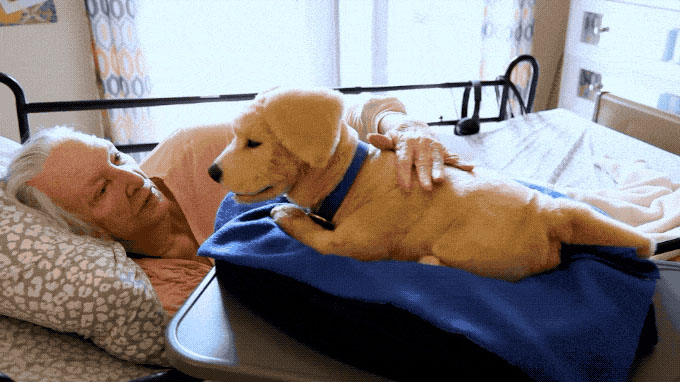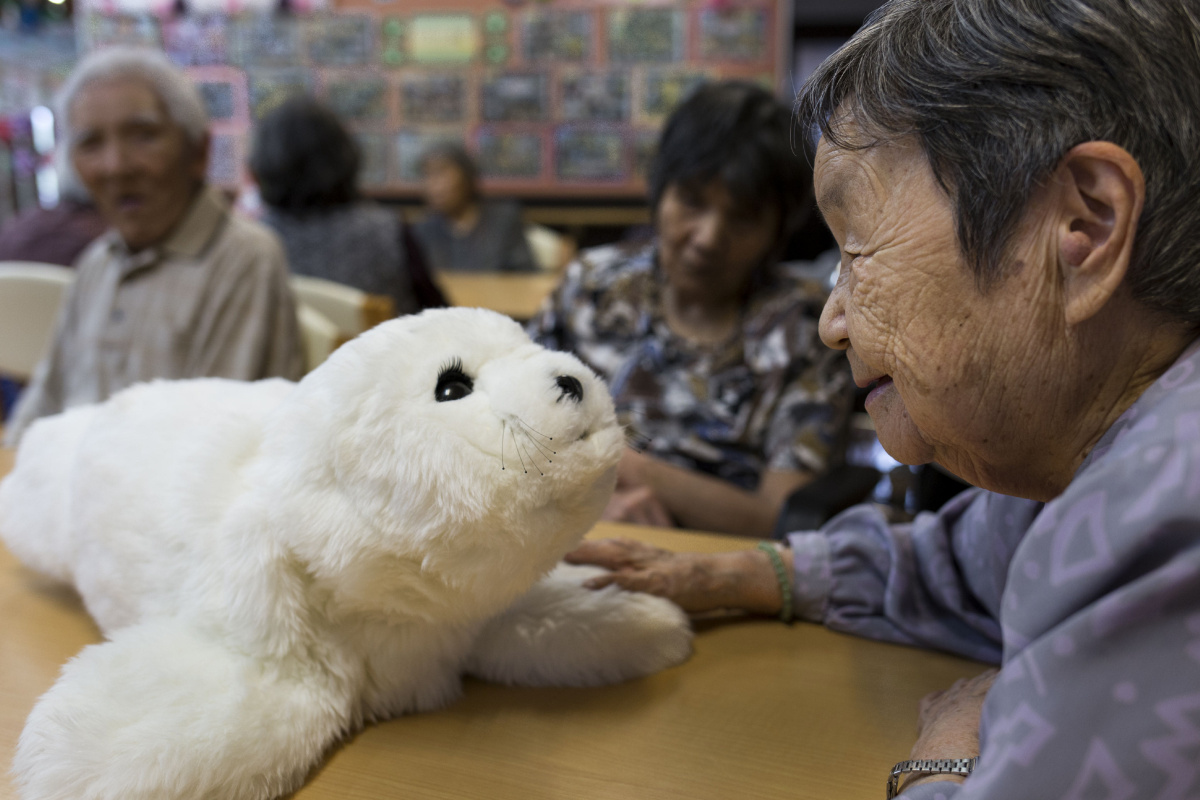Robots: Robo-Pets
November 13, 2022 § 6 Comments
Over the summer, my parents, siblings, and I welcomed Amber into our family. Amber is our beautiful one-year-old rescue dog, and as any pet owner will tell you, a lot of factors played into our decision to adopt her. Her personality, physical appearance, and way she interacted with us and our other dogs all helped us fall in love with her, and welcome her into the family with open arms.

Amber has provided my family with joy, companionship, and comfort, especially when we recently had to say goodbye to our childhood dog, Saffron. As my siblings and I grow older, our pets help keep the empty nest of our home from feeling so lonely. In the words of my mom, Leslie Ilany, “We are so grateful for our pups, especially for their antics and companionship as our children have grown and become more independent. Thankfully, the dogs offer a compelling reason to return home for a visit!”
As much as we love them, as my mother will also be the first to tell you that pets take a lot of work to upkeep. Between feeding, walking, and cleaning up after them, not everybody has the ability to have a furry friend around to keep them company. Elderly folks, of whom ¼ are considered to be socially isolated (cdc.gov), are a prime example of a population that could greatly benefit from a pet’s companionship, but who are physically and sometimes cognitively unable to care for a typical dog or cat. However, there is a whole market of robotic, low-maintenance pets available that are designed for the elderly, hospital patients, sufferers of Alzheimer’s/Dementia, and even children with Autism. Let’s take a look at some of them.
Up first, we have Hasbro’s JOY FOR ALL Companion Pets. With both cats and dogs available, this robotic companion is the most affordable and least sophisticated option. Selling at around $125, these furry creatures are available for purchase on Amazon. They don’t move, but this is on purpose, to make them as low-maintenance as possible for people who cannot care for living pets. There are both touch and light sensors along the body, to allow these robot pets to roll onto their backs when their stomachs are scratched, as well as blink, move their heads/bodies, and even bark or meow on command. Roboticsandautomationnews.com explains how these “pets” are helpful for those who suffer from Alzheimer’s/Dementia – “People with mental problems perceive them better than real cats and dogs: artificial animals are always ready for affection, their behavior is predictable, they don’t get angry, don’t scratch, don’t bite and don’t need care.”

Similar to the Hasbro robot pets, Tombot’s “Jennie” ($449) is a yellow lab puppy who is also immobile, is programmed to react to being pet, and can bark on command. Both Jennie and the Hasbro robotic pets do not contain any sort of AI or machine learning, and therefore can only react in preprogrammed ways. However, both low-maintenance options can help vulnerable populations combat feelings of stress, loneliness, anxiety, and depression.

In addition to these programmed puppies, there also exists more sophisticated (and more expensive) robot pet options, who utilize AI and machine learning to act more like actual pets. Up first we have PARO, a robotic baby seal created by Japan’s National Institute of Advanced Industrial Science and Technology. PARO retails for $5,000, and with such a hefty price tag comes much more complexity than the other robot pets we’ve seen so far. PARO has tactile, light, temperature, audio, and posture sensors, all of which help him perceive and interact with his people and environment. PARO can tell when he’s being pet (tactile sensor), held (posture sensor), and can recognize the direction of voice and words to react to his name, greetings, and even praise. With the integration of AI, “PARO can learn to behave in a way that the user prefers, and to respond to its new name. For example, if you stroke it every time you touch it, PARO will remember your previous action and try to repeat that action to be stroked. If you hit it, PARO remembers its previous action and tries not to do that action” (parorobots.com). As if this little guy wasn’t cute enough, PARO even charges via a pacifier!


Another robot pet that utilizes AI is SONY’s aibo. Unlike the other examples of robot pets we’ve seen so far, aibo embraces the fact that it’s just that – a robot. Like Ava in Alex Garland’s Ex Machina, aibo does not attempt to look like a living puppy, but that does not mean that it does not try to act like a(n enhanced) pup. Since I admittedly do not know what all of this means, I will quote Robotics and Automation News in saying that aibo is “equipped with a video camera for recognizing surrounding objects, sensors for temperature, distance, vibration, light, (with) sensors on the head and back. Inside the puppy, there’s a 64-bit processor that processes the received data. Thanks to the drive system, its body can move along 22 axes. Two OLED screens are used as eyes.” While I can’t tell you what all of this means, I can tell you that it’s very advanced, as aibo is one of the most complex robot pets on the market (which also explains why it retails for $2,900, with an annual recurring fee of $300 for the AI Cloud Plan Renewal). aibo is constantly learning and adapting to its owner’s preferences and its environment, but the way it does this is a little bit unsettling. aibo remembers everything that it’s ever seen, so its AI forms a response based on the current stimulus, and also everything else that it’s ever seen. All of the photos and data from aibo’s memory can be accessed at any time, which eerily approaches the same concept explored in Black Mirror’s “The Entire History of You,” where everybody has access to memory implants that record everything that they ever see, do, and hear.
/cdn.vox-cdn.com/uploads/chorus_asset/file/13707771/aibo2.jpg)
Especially when considering the context of the COVID-19 pandemic, these robotic pets can be fantastic alternatives for those with mental disabilities or memory impairments that cannot care for real, living pets. They can provide mental and physical stimulation and combat feelings of loneliness and loss (possibly coming from the loss of a real pet). It is also not hard to think of additional ways that these robo-pets could help the elderly. One idea that I have is incorporating a “call help” button onto the mobile robot pets, so that if one were to fall and be unable to get help, they could call out to their robo-dog and press the button. However, there are definitely challenges that exist with robot-pets. The uncanny valley is as real as ever, as is the logistical problem that seniors are often not very tech-savvy, especially when facing cognitive declines. Additionally, robot friends like Moxie have been met with some harsh criticism – do robot pets elicit the same reactions, or do we as people feel more comfortable with animals being imitated by technology than we do people? I’m interested to find out.
Sarah Ilany

This makes a lot of sense. That’s my first reaction: the sheer logic of robotic pets, especially “emotional support” animals and companions for the elderly. They don’t need to be cared for, they are predictable, and if they still give the emotional benefits of companionship and caring-for, then, well, this might be brilliant.
Except…part of me worries that this kind of robotic animal-care will work against our treatment of real animals. If caring robotic pets become normalized, the nuanced difficulties of real pet-ownership might become even less understood than they already are.
But still: this makes more sense to me than “learning” robots like Moxie.
LikeLike
Hi Sarah, I found myself very conflicted about the topic of your discussion this week. On one hand, robotic pets can serve as a good means for people to gain emotional support and companionship to combat feelings of stress and anxiety. However, the technology is also reminiscent of the Moxie robot which makes me consider the idea that it may create a hindrance to users’ social development and ability to interact with others. Despite these mixed feelings about the concept, I do lean more toward its benefits. I also found it really interesting how one of the options for a robotic pet is a seal. By creating the option for people to have various kinds of robotic pets, it could reduce/dismantle the exotic pet market and allow for a healthier ecosystem and environment. It is also a good way to expose children to various animals and help them learn more about them through a hands-on learning experience. I just hope in the future these pets do not learn how to bite.
LikeLike
This is so interesting, Sarah! I think I’m most familiar with robotic pets through iDog and Fur Real Friends, but I never considered the therapeutic applications. We’ve had a lot of discussion about the merit of “real” versus robotic products, but this feels like the most valuable transmogrification of a “real” pet. Aaron already touched on this in his comment, but these robotic pets allow for a larger variety of animals, including seals. The distinction between robotic and living pets is an important one because it considers each owner’s ability and allows for an optimal care experience. Thank you for introducing me to the new world of robotic pets, I’m absolutely going to go down a rabbit hole. 🙂
LikeLike
Hi, Sarah. What an intriguing concept! I personally see these innovations as mostly positive, especially within the context of providing companionship for the elderly and disabled. However, I also see some clear drawbacks. With the advent of robo-pets, is it not worrisome that real-life, biological pets may become obsolete down the line? Assuming that this technology continues to advance, I imagine that the benefits of robo-pets will become increasingly more glaring. By contrast, I expect that the drawbacks of having to care for biological pets will become less and less worth their companionship, even in the cases of non-elderly/disabled individuals. According to the American Society for the Prevention of Cruelty to Animals, of the 6.3 million pets that enter shelters each year, approximately 920,000 are euthanized annually. If robo-pets continue to increase in popularity, is it not reasonable to assume that this figure will grow in turn?
https://www.aspca.org/helping-people-pets/shelter-intake-and-surrender/pet-statistics
LikeLike
I truly hadn’t thought about the positive applications of robotic pets before reading your article. I would have to agree that for elderly people with dementia, people with mobility issues, and others that having an alive pet would pose caretaking issues this technology is wonderful. If it genuinely comforts these people, I think in the proper application, emotionally attaching oneself to a robotic pet isn’t harmful. I think the tech-savviness of the elderly generation is a valid concern, but I imagine many of these robotic pets are used in nursing homes where aids can help with minor tech issues. The pet that creeped me out the most was the “aibo” dog, partially because of its appearance, but also because of the frightning degree of memory storage. I feel like it’s dangerous to have a machine store constant video and audio data that can be accessed anytime from when it’s powering-on. We experience enough issues with hackers stealing social security numbers, credit cards, etc…there’s a huge possibility for misuse of this information. Not to mention, the concerns about the morals of the company making these bots and whether they would sell the data to other companies. All to say, you bring up some significant points in the discussion of pros and cons of robotic pets that I hadn’t considered before. Great article, Sarah!
LikeLike
Thanks for your informative post! I remember seeing advertisements on Disney and other children’s channels for robo-pet toys that were much less sophisticated and more cost-effective than the ones you wrote about. The creation of technology to aid those in our communities that need it the most is one of the main motivators in our world for creating technology, besides monetary profit. These toys seem to do just this, and in ways I never thought about before. Specifically, the predictable behavior patterns of robo-pets being something that makes them more appealing to some neurodivergent and differently abled people was an interesting factor that I did not think about. However, I thought that the aibo’s method of learning its users preferences by remembering everything it sees and hears was a bit unstintingly and reminded me of the Black Mirror episode you mentioned, “The Entire History of You.”
LikeLike